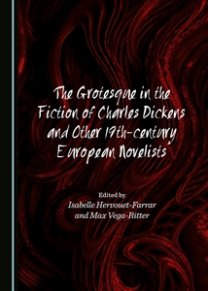
I. Hervouet-Farrar & M. Vega-Ritter (dir.), The grotesque in the fiction of Charles Dickens and other 19 th-century european novelists
The grotesque in the fiction of Charles Dickens and other 19 th-century european novelists
Sous la direction de Isabelle Hervouet-Farrar & Max Vega-Ritter
Newcastle-upon-Tyne, Cambridge Scholars Publishing, 2014.
EAN 9781443867566.
241 p.
Prix 47,99£
This book provides an overview of the literary grotesque in 19th-century Europe, with special emphasis on Charles Dickens, whose use of this complex aesthetic category is thus addressed in relation with other 19th-century European writers. The crossing of geographical boundaries allows an in-depth study of the different modes of the grotesque found in 19th-century fiction. It provides a comprehensive analysis of the reasons behind the extensive use of such a favoured mode of expression. Intertextuality and comparative or cultural analysis are thus used here to shed new light on Dickens’s influences (both given and received), as well as to compare and contrast his use of the grotesque with that of key 19th-century writers like Hugo, Gogol, Thackeray, Hardy and a few others. The essays of this volume examine the various forms taken by the grotesque in 19th-century European fiction, such as, for example, the fusion of the familiar and the uncanny, or of the terrifying and the comic; as well as the figures and narrative techniques best suited for the expression of a novelist’s grotesque vision of the world. These essays contribute to an assessment of the links between the grotesque, the gothic and the fantastic, and, more generally, the genres and aesthetic categories which the 19th-century grotesque fed on, like caricature, the macabre and tragicomedy. They also examine the novelists’ grotesque as contributing to the questioning of society in Victorian Britain and 19th-century Europe, echoing its raging conflicts and the shocks of scientific progress. This study naturally adopts as its theoretical basis the works of key theorists and critics of the grotesque: namely, Victor Hugo, Charles Baudelaire and John Ruskin in the 19th century, and Mikhail Bakhtin, Wolfgang Kayser, Geoffrey Harpham and Elisheva Rosen in the 20th century.
Introduction: The Grotesque in the Nineteenth Century
Isabelle Hervouet-Farrar
Part I: Influences and Early Forms
Chapter One
L’Histoire du roi de Bohême and Oliver Twist under Cruikshank’s Patronage: The Dynamics of Text and Image at the Core of the Grotesque in the Novel of the 1830s
Dominique Peyrache-Leborgne
Chapter Two
The Grotesque and the “Drama of the Body” in Notre-Dame de Paris and The Man who Laughs by Victor Hugo
Sylvie Jeanneret
Chapter Three
From Smollett to Dickens: Roderick (Random), Barnaby (Rudge), and the Raven
Anne Rouhette
Chapter Four
Of Giants and Grotesques: The Dickensian Grotesque and the Return from Italy
Michael Hollington
Part II: Expressing 19th-century Reality: Reason vs. Unreason
Chapter Five
Grotesque Extravagance in the Fictional Worlds of Charles Dickens and Nicolas Gogol from the Perspectives of “Fantastic Realism” and the European Grotesque Tradition
Florence Clerc
Chapter Six
Figures of the Grotesque in The Snobs of England / The Book of Snobs, by William Makepeace Thackeray
Jacqueline Fromonot
Chapter Seven
From “Absolute Realism” to Nocturnal Grotesque in Gérard de Nerval’s October Nights
Bérangère Chaumont
Chapter Eight
The Flâneur and the Grotesque Figures of the Metropolis in the Works of Charles Dickens and Charles Baudelaire
Isabel Vila-Cabanes
Chapter Nine
The Construction of the Monstrous in Charles Dickens’s Fiction from The Old Curiosity Shop to A Tale of Two Cities
Max Véga-Ritter
Chapter Ten
An “Uncanny Revel”: The Poetics and Politics of the Grotesque in Thomas Hardy’s The Mayor of Casterbridge
Thierry Goater
Part III: Resisting and Negotiating Change
Chapter Eleven
“Primitive Elements in a Modern Context”: The Grotesque in The Mystery of Edwin Drood
Isabelle Hervouet-Farrar
Chapter Twelve
Arts of Dismemberment, Anatomy, Articulation and the Grotesque Body in Our Mutual Friend
Victor Sage
Chapter Thirteen
The Grotesque and Darwin’s Theory in Charles Dickens’s Great Expectations and Wilkie Collins’s No Name
Delphine Cadwallader-Bourron
Chapter Fourteen
The Female Grotesque in Dickens
Marianne Camus
Chapter Fifteen
Zuleika Dobson by Max Beerbohm: The Grotesque of not such a Gross Text
Gilbert Pham-Thanh
Chapter Sixteen
The Return of Dickens’s Grotesques on Screen
Florence Bigo-Renault
Conclusion: Regeneration and Permanence of the Grotesque
Isabelle Hervouet-Farrar
Contributors
Index